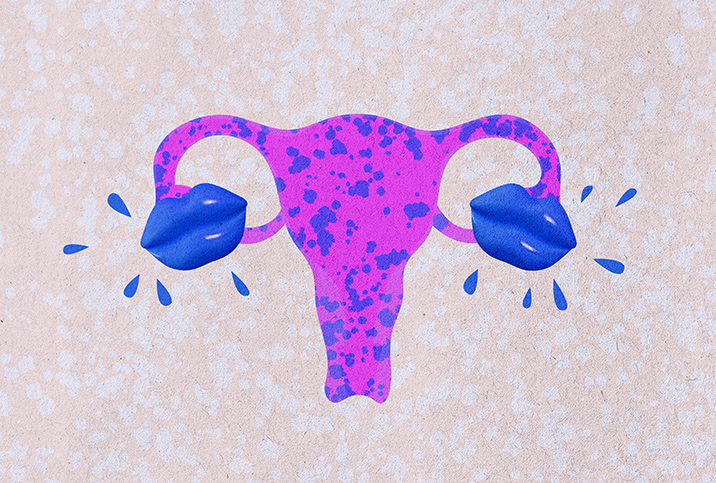Your Ovaries Are Constantly Changing Size

The ovaries are essential organs for reproduction. But did you know they change in size during your lifetime? Ovaries not only shrink with age, but their size also fluctuates monthly depending on the stages of your menstrual cycle. Their size can also foretell whether a woman will transition into menopause early.
How ovaries develop and change size over time
Ovaries start developing when the embryo is around 8 weeks old, and the ovaries of a newborn baby girl are approximately 1 centimeter (cm) in size, weighing about 250 to 350 milligrams (mg). Between their first period and reaching menopause, an average woman's fertility cycle lasts around 35 to 40 years, resulting in 400 to 500 ovulation and menstruation cycles during their lifetime.
At birth, the female body already contains all the cells that a woman will ovulate during her lifetime. The ovaries don't produce a new egg each month. The ovulated egg is as old as the woman.
Zahra Ameen, M.B.B.S., a consultant OB-GYN at Cadogan Clinic in London, explained how the ovaries change size.
"During the follicular phase, days 6 to 13, follicle-stimulating hormone is released from the pituitary gland in the brain to stimulate the ovary and so the development of the dominant follicle. This is the egg which will be released during ovulation. A sudden surge in luteinizing hormone on day 14 will lead to ovulation," she said. "Therefore, the volume of the dominant ovary is increased during the follicular phase, decreased after follicular rupture—release of the egg—and then increased again during the luteal phase, days 15 to 28 of the cycle."
The average size of an adult woman's ovary is 3 to 4 cm, and it shrinks to around .5 to 1 cm after menopause. The reason for the change in size is the declining levels of estrogen released from the ovaries and the significantly reduced number of follicles, Ameen noted.
How does a woman know if she has early menopause?
Ovaries containing the follicles necessary for ovulation are visible on an ultrasound scan, Ameen explained.
"During the younger reproductive years—from the onset of puberty—each of the ovaries contains 300,000 to 400,000 follicles. This is seen on [the] scan as an ovary which is easy to visualize, measuring around 3 to 4 centimeters with multiple follicles and a volume of 10 cubic centimeters or less," she said. "Following menopause, the number of follicles and estrogen levels significantly decline, [and] the appearance of the ovaries is described as atrophic: small, 1 centimeter or less, more difficult to visualize [with] minimal or no follicles seen."
Postmenopausal ovaries not only appear smaller in size but are often not visible on ultrasound due to the lack of follicles. That's usually a good sign because it shows no indication of disease.
A four-year longitudinal study on the changes in ultrasound imaging of the uterus and ovaries during the menopausal transition and early postmenopause observed 20 Scandinavian women with reasonably regular periods. The 50-year-old participants had transvaginal ultrasound examinations every three months until they reached 12 months after menopause, then every six months in the last year. The research presents results from two years leading up to menopause to two years after menopause.
Over the four years, the participants' left and right ovarian volumes decreased 45 percent and 20 percent (median), respectively, while the diameter of their uterus decreased an average of 22 percent. The total number of follicle-like cystic structures varied from zero to five before menopause. At menopause, this number was zero to seven; one year after menopause, it decreased to zero to four, then further reduced to zero to two in the last year.
Other reasons ovaries change size
There are several other reasons for size fluctuations, and most of them cause your ovaries to become enlarged, according to Kecia Gaither, M.D., a board-certified OB-GYN and maternal-fetal medicine expert in the Bronx, New York.
"During pregnancy, hormonal influences of estrogen and progesterone result in ovarian enlargement," she said. "For women undergoing infertility treatments, hormonal therapies result in ovarian stimulation to produce more eggs, hence, the ovaries are transiently enlarged."
Abnormalities causing larger than average ovaries
However, not all ovarian size changes are normal. Gaither explained that underlying pathological conditions such as polycystic ovary syndrome (PCOS) could cause shifts in their dimensions.
"In this situation, the ovaries are enlarged, with associated comorbid conditions of infertility, irregular menses, hirsutism, obesity [and] diabetes," she said.
According to the National Health Service (NHS) in the United Kingdom, PCOS affects 1 in 10 women in the U.K., and more than half of them are symptomless. In the U.S., the condition impacts 5 percent to 18 percent of women of reproductive age.
Polycystic ovaries hold loads of harmless follicles that are up to 8 millimeters in size. Since these follicles are underdeveloped sacs, they're unable to release an egg. Therefore, no ovulation occurs.
Other conditions resulting in larger than usual ovaries are endometriosis and ovarian cancer, Gaither concluded.
So while some changes in ovarian size may be harmless, paying attention to any abnormal symptoms can help you detect further concerns.


















